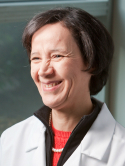Functional and genomic approaches reveal an ancient CHEK2 allele associated with breast cancer in the Ashkenazi Jewish population Journal Article
| Authors: | Shaag, A.; Walsh, T.; Renbaum, P.; Kirchhoff, T.; Nafa, K.; Shiovitz, S.; Mandell, J. B.; Welcsh, P.; Lee, M. K.; Ellis, N.; Offit, K.; Levy-Lahad, E.; King, M. C. |
| Article Title: | Functional and genomic approaches reveal an ancient CHEK2 allele associated with breast cancer in the Ashkenazi Jewish population |
| Abstract: | Functional and genomic approaches can be integrated to screen efficiently for pathogenic alleles in founder populations. We applied such approaches to analysis of the cancer-associated cell cycle regulator CHEK2 in the Ashkenazi Jewish population. We first identified two extended haplotypes at CHEK2 that co-segregated with breast cancer in high-risk families. We sequenced CHEK2 in a case representing each haplotype and discovered two novel amino acid substitutions, CHEK2.S428F in the kinase domain and CHEK2.P85L in the N-terminal region. To assay these alleles for loss of CHEK2 function, we tested their capacity to complement Rad53 deletion in Saccharomyces cerevisiae. CHEK2.S428F failed to complement Rad53 and thus largely abrogates normal CHEK2 function, whereas CHEK2.P85L complemented Rad53 as well as did wild-type CHEK2. Epidemiologic analyses were concordant with the functional tests. Frequencies of CHEK2.S428F heterozygotes were 2.88% (47/1632) among female breast cancer patients not selected for family history or age at diagnosis and 1.37% (23/1673) among controls (OR = 2.13, 95% CI [1.26, 3.69], P = 0.004), whereas frequencies of CHEK2.P85L were 0.92% among cases and 0.83% among controls. On the basis of the experience of mothers, sisters and daughters of probands, breast cancer risk due to CHEK2.S428F was estimated as 0.17 (±0.08) by age 60. We conclude that CHEK2.S428F increases breast cancer risk ∼2-fold among Ashkenazi Jewish women, whereas CHEK2.P85L is a neutral allele. In general, these results suggest that selecting probands with extended haplotypes that co-segregate with disease can improve the efficiency of resequencing efforts and that quantitative complementation tests in yeast can be used to evaluate variants in genes with highly conserved function. © Oxford University Press 2005; all rights reserved. |
| Keywords: | adult; controlled study; major clinical study; sequence analysis; gene deletion; mutation; sequence deletion; cancer risk; protein domain; cell cycle proteins; allele; cancer susceptibility; genetic predisposition to disease; breast cancer; amino acid substitution; gene frequency; haplotypes; risk factors; mutational analysis; breast neoplasms; heterozygote; wild type; haplotype; amino terminal sequence; saccharomyces cerevisiae; protein-serine-threonine kinases; heterozygosity; quantitative analysis; family history; checkpoint kinase 2; high risk population; saccharomyces cerevisiae proteins; genetic predisposition; genetic screening; onset age; breast carcinogenesis; jews; functional genomics; genetic complementation; frequency analysis; genetic complementation test; population genetics; epidemiological data |
| Journal Title: | Human Molecular Genetics |
| Volume: | 14 |
| Issue: | 4 |
| ISSN: | 0964-6906 |
| Publisher: | Oxford University Press |
| Date Published: | 2005-02-15 |
| Start Page: | 555 |
| End Page: | 563 |
| Language: | English |
| DOI: | 10.1093/hmg/ddi052 |
| PUBMED: | 15649950 |
| PROVIDER: | scopus |
| DOI/URL: | |
| Notes: | --- - "Cited By (since 1996): 41" - "Export Date: 24 October 2012" - "CODEN: HMGEE" - "Source: Scopus" |
Altmetric
Citation Impact
BMJ Impact Analytics
Related MSK Work





